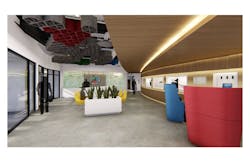Strategies for Working with Corporate Interior Design Standards Post-Pandemic
One of the long-term legacies of the COVID-19 pandemic will be its impact on the design and layout of corporate workspaces. As companies begin to adjust to the “new normal,” the current corporate work environment, with its open office configurations, team-based workspaces, collaborative huddle rooms and emphasis on flexibility, will need to change in the post-pandemic economy. The universal acceptance and success of work-from-home options, combined with the need to reduce density in order to meet physical distancing requirements will necessitate that many companies update their interior design standards.
While some designers may feel constrained by working within standards, they afford an excellent opportunity to showcase interior design skills and working within a budget. Below are insights to key challenges, solutions and strategies to keep in mind when working with interior design standards.
Benefit of Interior Design Standards
Interior design standards are a critical component in establishing consistent expectations for space utilization and layout by facilitating solutions that reflect a company’s brand and image. Interior design standards impact all aspects of the built environment—furniture, lighting, carpeting, amenities, etc.—and should incorporate ergonomics and adjustability. The standardization of furniture, fixtures and equipment reduces maintenance and repair costs, allowing properties to operate more economically and efficiently.
Standards also create an economy of scale that provides increased purchasing power resulting in deep quantity discounts. Lastly, interior design standards also offer human resources benefits, as they ensure that workspaces are consistent for all employees, regardless of title.
One Size Does Not Fit All
It is important to remember that interior design standards are client specific. For example, a set of standards developed for one corporate organization may not be interchangeably applied to another. Corporate culture, brand identity, historical space utilization, ratio of support staff to senior staff and budget can significantly impact the development and implementation of interior design standards. Similarly, once they are in place, standards should inform design decisions, but not dictate every detail. Consider standards as guidelines for design; they are not meant to be applied as a cookie-cutter solution for space layout.
Standards Need to Evolve
The impact of the pandemic on corporate real estate space utilization is proof positive that interior design standards need to evolve and respond to changing business models. Pre-pandemic, interior standards focused on supporting and encouraging collaboration and communication as evidenced by large open space footprints.
Just as 9/11 impacted our travel protocols, the pandemic has ushered in new social distancing requirements and an emphasis on touchless interfaces in public areas such as elevators, lobbies and washrooms. As a result, standards will need to evolve to reflect more private workspaces, added employee protection measures, and an increased attention to cleaning and maintenance protocols.
Streamlines Design Process
Interior design standards, once developed and approved, can help facilitate consensus among key stake holders and streamline the design process. A well-conceived design vocabulary in tandem with agreed-to color and material palettes and furniture standards minimizes a substantial amount of conflict around the design process. Rather than arguing over square footage and furniture options, standards allow the design team and stakeholders to concentrate on space requirements that are unique to their department. They also improve design efficiency, and often provide the best value for your design dollar.
Supporting Parity Across Multiple Locations
Interior design standards are especially useful when working with organizations that have multiple locations, as they provide a blueprint for parity across campuses. This is especially important when designing environments for companies with international locations. Having an office environment that evokes your brand and allows your employees to feel comfortable supports an increasingly mobile workforce as well as enhances productivity. Small details, like where the office supplies are kept or the location of coffee stations, play an important role in making your employees feel at home away from home.
This is one of the primary reasons hotel brands are so meticulous regarding their interior design and building standards, as they are proven drivers of brand loyalty. When working internationally, be aware that overly strict standards can prevent the use of local vendors or craftsmen because they are unable to meet the specific bid requirements outlined in the standards.
Importance of Change Management Procedures
Standards may be about physical space, but they have a significant impact on employee morale and culture. It is critically important to secure the approval and participation of senior management when developing and implementing standards.
For example, in a recent corporate office renovation, senior management openly advocated an open plan approach by explaining to staff at a town hall meeting that the design supported a one-to-one relationship between open seating and available private spaces, which helped achieve company-wide acceptance for the new seating standards.
Challenges Working Within Standards
Many businesses have made significant investments in documenting and specifying their interior design standards. When working with a new set of standards, thoroughly review the documentation and visit an existing facility where the standards have been implemented. Seeing the standards in place and observing how they work collectively will greatly assist in the design process.
Often interior design standards are based on sample floorplan layouts in simple building shells. When faced with complex building envelopes and challenging column spacing, challenges will arise. For example, a standard may identify a specific private office-to-open-space ratio, but the space to be fit-out does not have enough square footage to meet the standard’s specifications. Identifying and working through these issues with your client early in the design process can result in a solution that solves the unique spatial constraints while reflecting the intent of the standards.
How One Company Has Navigated Corporate Standards During the Pandemic
With the goal of prioritizing employee health and safety, many organizations find themselves at a crossroads regarding their corporate space standards. Do they maintain their current footprint and regulate employee density by staggering in-office days with work-from-home days, or do they acquire additional square footage to accommodate current and projected employee growth to support social distancing requirements?
Universal Display Corporation (UDC) faced exactly this dilemma. An inventor and developer of OLED technologies and materials that are critical components of consumer electronic devices such as smartphones, TVs and IT (tablets, notebooks and monitors), this publicly traded firm has its headquarters and research and development (R&D) facilities in Ewing, New Jersey, as well as additional international offices in Ireland, South Korea, China, Hong Kong, Japan and Taiwan.
[Related: Designing a Post-COVID Workplace That Helps Employees Feel Better]
With the ongoing proliferation of OLED products, UDC has experienced strong growth in the last several years and was included on Fortune’s 2020 Fastest-Growing Companies list, the fourth time that the firm has ranked on the publication’s annual ranking.
In the fall of 2019, prior to the COVID-19 pandemic, UDC recognized the need to expand their facility footprint due to projected growth. All administrative and R&D personnel shared space in a two-story facility, Building A.
Understanding that relocating its cleanrooms in Building A would be cost prohibitive, and needing to expand their R&D capacity, UDC decided to decant all administrative/office functions and identified two buildings in the office complex within walking distance of the existing space in Building A. Offices and technical support space would be relocated to Building B. Building C would house employee collaboration and amenity spaces, such as a community great room, cafeteria, touchdown business center and conferencing facilities.
Existing Conditions
UDC had grown organically over time and most employees had become accustomed to having two people share a private office. In existing Building A, management offices were arranged around the perimeter of the building with partitioned cubicle workstations opposite, creating long corridors with little or no access to natural light.
Pre-Pandemic Design—Open Plan
Wishing to encourage collaboration among different departments and constrained by available square footage in Building A, in the fall of 2019 UDC approved an open office floor plan concept that featured corporate office standards that reduced both the number of private offices from 60 to 20, but also the size of executive offices from 240 square feet to 100 square feet.
Post-Pandemic Design—Private Office Plan
As the design team moved forward with design development documentation, the pandemic began to appear in Asia. In March of 2020, it quickly became apparent that the new corporate open office standards would not meet social distancing requirements and placing the safety of their employees at the forefront of decision making, UDC instructed the design team to revisit the standards and develop new guidelines and a layout that would support social distancing. The resulting floor plan increased the number of private offices from 20 to 40, as well as increased the square footage of the four executive-level offices from 100 square feet to 200 square feet.
Flexibility Built into Design
To provide future space for expansion, the connecting wall between the majority of the private offices feature demising walls that can easily be taken out to create a more open and collaborative office space for two employees once pandemic precautions are no longer required. Envisioned prior to the pandemic as a company-wide community gathering space, Building C will provide additional overflow workspace to address employee density in Building B. Because the buildings are adjacent to each other and share a paved surface, a canopy has been designed to provide protection from the elements and encourage connectivity between buildings.
Comparison of Office Space Standards
Designing in a pandemic has emphasized the importance of flexibility in office standards development. Below is a comparison of square footage for each of the three floor plans.
Summary
While certainly disruptive, the pandemic’s impact offers an opportune time for companies to reinvent workspaces that will contribute to safe environments where employees can enjoy their work, collaborate with their colleagues and achieve the objectives of their organizations. Well thought-out interior design standards can provide flexibility to help companies navigate “the new normal” as we enter the post pandemic era.
About the author: Jacqueline Wolverton, IIDA, is the Interior Design Studio Lead for HDR.
Read next: The Third Place: Redefining the New Workspace Without the Workplace
About the Author

firstName lastName
i+s partners with design practitioners and other industry experts to deliver informative and engaging content on a variety of topics related to commercial interior design, from the latest trends, research and technology to innovative projects, products and educational CEUs. Interested in becoming a contributor? Contact us today!
